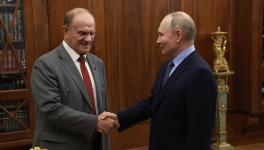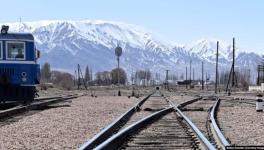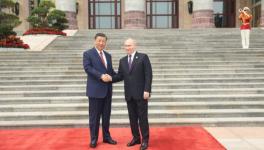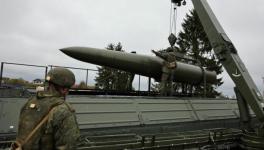Modi’s US Visit: High on Atmospherics Short on Substance
Newsclick interviewed Seema Mustafa, senior journalist and a foreign policy expert, on PM Modi's 4th visit to the United States. Even as the Indian media is going gaga over Prime Minister Modi's visit, it seems to have achieved very little. This visit, initiated at India’s behest, saw Modi addressing the US Congress, a joint statement by the two governments, and atmospherics typical of his foreign trips. In concrete terms, while no major agreement such as the Logistics Service Agreement has been signed, both sides talked of being "allies" and "partners", a significant departure from India's foreign policy.
Rough Transcript:
D. Raghunandan (Raghu): Hello and Welcome to Newsclick, this episode in collaboration with The Real News. The mainstream media in India has been going gaga, as it always does whenever Prime Minister Modi visits the United States or meets with President Obama, anticipating one or the other major takeaway. However, this time there doesn't seem to be any -- very specific take aways – from the Modi-Obama meeting. To understand this better, we have with us today veteran journalist Seema Mustafa. Welcome Seema.
Seema Mustafa (Seema): Hi
Raghu: Seema, let me begin by asking you, the joint statement by the two leaders as well as the text of Prime Minister Modi's address to Congress, is full of generalities, a lot of atmospherics but short on specifics.
Seema: Yes.
Raghu: Do you think that this is itself deliberate that in a sense the outcome of this visit is perhaps just as much in the atmospherics of this burgeoning strategic alliance, as it is on any specific nitty gritty?
Seema: Yes, I think so. I think the whole idea is of atmospherics, and from whatever we have learned, it seems this particular visit is initiated by India. India was very keen to make this visit even though President Obama is now the outgoing President and we wanted a “state visit” which they were not willing to give. So it became a “working visit”. Having said that somehow, I think for Prime Minister Modi the atmospherics, and the grand stage that he comes to occupy when he visits New York or Washington, or stands next to Obama, who is of course a world leader, is becoming addictive you know. I mean why would you constantly make these visits until you were getting something now? Now you expect something substantive in terms of sealing some agreements that were talked about earlier, moving something forward, but neither of that seems to have happened.
Raghu: Right and as you said the President Obama is on his way out. So it's not likely he is going to make any major commitments on the behalf of the United States. Plus, I also found it noteworthy that Secretary of State Kerry was not in town. He was busy with the China summit. Defense Secretary Ashton Carter was not there. He was busy with the Shangri La dialogue. So the substance of a summit level meeting really doesn't seem to be there.
Seema: It didn't really, and it was like even the photo op wasn't there, because I was checking on the photographs there are far few photographs then used to have when these two met in the past. If you look at the joint statement, it almost seems as if there is a whole bunch of things that were agreed upon or written about just added on. You know, it's like a long statement with – like you said – with nothing substantive. I mean on the nuclear deal, they are talking about the Westinghouse now. They said (that) a year later, the work is going to be in a preparatory stage. Where is it all going? What has he achieved? There has been not much on defense except something that we have heard constantly that we are their defense partner. In fact, we have been hearing all these things and perhaps even more little substance under Prime Minister Manmohan Singh. So from then to now, what?
Raghu: Does it convey however, even if there has been lack of substance we have been talking about, no specific deals or nitty gritty. But does that itself convey that the two countries are settling in to a cosy alliance. They don't need to make a big show out of this but when the leaders get together, they are discussing many strategic issues which don't necessarily see the light of day in terms of very concrete deals.
Seema: I think both the establishments and both the leaders particularly need each other. For President Obama you know sort of packed with foreign policy failures and particularly in West Asia, India is a bit of success story that he has moved out of the Pakistan paradigm, the parameters have moved into India and he has got a whole bunch of whole things going on with India. For Prime Minister Modi, acceptability by the US amounts, to global acceptability. The outcast turned a hero, speaking at the US Congress getting standing ovations all these is very heavy business. I think at the end of the Obama's term, he is very happy with this. He wants to sort of right the final few words about this relationship with India which he was able to do through this visit and I think, Prime Minister Modi is looking ahead and should be looking ahead and one don't really get that impression. But looking ahead at Donald Trump, the next President of the US...
Raghu: I did notice from the joint statement of the however, there is this emphasis on the US recognizing India as a major defense partner which is a relatively new formulation coming from the US, and specifically saying that this puts India on a par with other allies. That was one formulation that struck me as being somewhat new and there was also an underlining of the joint interests between the India and the United States in the Asia Pacific region and the Indian Ocean region and I think the strategic significance of that can not be overlooked.
Seema: Absolutely. I think the defense framework... somehow Raghu, I have a slightly different approach because I remember, when the defense framework agreement was signed with Manmohan Singh at that time, similar kind of noises were made and the rhetoric may be nuanced a little further this time, but the rhetoric was that we have arrived. We started all those joint military exercises. I think sticking point in this still remains and that sticking point is boots on the ground in West Asia. That's something which I know for a fact – that US senior officials told us in an off the record briefing not so long ago -- that if you want to be counted amongst the big guys, then be there where the action is. Which means send your armies into the area, into the coalitions that the Americans are forging. So I don' know how far -- I am sure Americans have been talking about because they are very keen on to involve the India army – and I don't know how far that has gone. But that would be really the crux to finalize this defense framework.
Raghu: The logistics agreement which the two countries were supposed to signed seems to have made another inch of progress. We still haven't seen the documents being signed. They still seem to be dotting the i's and crossing the t's.
Seema: Yeah, it's interesting that the Bharatiya Janata Party (BJP) was opposed to the nuclear deal with the US, with the Hyde act, with all these agreements and all these protocol around it. And today, Prime Minister Modi is actually leading (on this). I think, apart from that logistics agreement which I think in principle India has agreed to sign just like Manmohan Singh had, and then the Congress leadership got cold feet nearer the elections, and they backed out from it. So let's see the cold feet emerge at all, because I don't think Rashtriya Swayam Sevak Sangh (RSS) is going to be very happy with this agreement of actually inviting Americans to have bases in India which is what it amounts to.
Raghu: I am told that India's Defense Minister Manohar Parrikar was at the Shangri-La dialogue with Ashton Carter and the two apparently went with a text of the logistics agreement and they did some dotting of the i's and then it moved ahead I think to the next phase. There seems to be a recognition of that in the joint statement as well.
Seema: Yes. It is there. It is there at the joint statement that they are looking at that and obviously, that's another thing that Americans are going to get. So at the end of the day, though there is not much substance if you weigh it then what is India got out of it, except atmospherics at the moment, what is America getting out of it, is obviously pushing us towards the logistics agreement and pushing us towards boots on the ground policy, pushing us to get more weapons from them and to get nuclear reactors from Westinghouse, which is anyway a dead outfit. So they get a lot of trade, a lot of business, big bucks and at the moment I am not very sure what India is getting.
Raghu: Except this feel good about being a partner of the United States.
Seema: Yes.
Raghu: I was reading the Chinese newspapers. They seem to have been following this agreement and have interpreted it as basically being a strategic defense agreement and they have cautioned India not to fire over American shoulders at China.
Seema: See that's it. Now, this is what one side of the atmospherics. What does it do to your region? It impacts your relationship with your neighbors. The Chinese already have said that they are opposing our bid for the Nuclear Suppliers Group. This is something. This was told to us a long time ago by the American government, saying if you do A,B,C.D, E,F, you are going to be sitting at high table. It didn't happen for so many years. It seems we are closer to it. But you know the way are going about it our Prime Minister flew to Switzerland and went to Mexico and the impression is being given that we can encircle China and we can get everybody on our side, and make China irrelevant. That doesn't really happen without angering the dragon.
DISCLAIMER: Please note that transcripts for Newsclick are typed from a recording of the program. Newsclick cannot guarantee their complete accuracy.
Get the latest reports & analysis with people's perspective on Protests, movements & deep analytical videos, discussions of the current affairs in your Telegram app. Subscribe to NewsClick's Telegram channel & get Real-Time updates on stories, as they get published on our website.
























